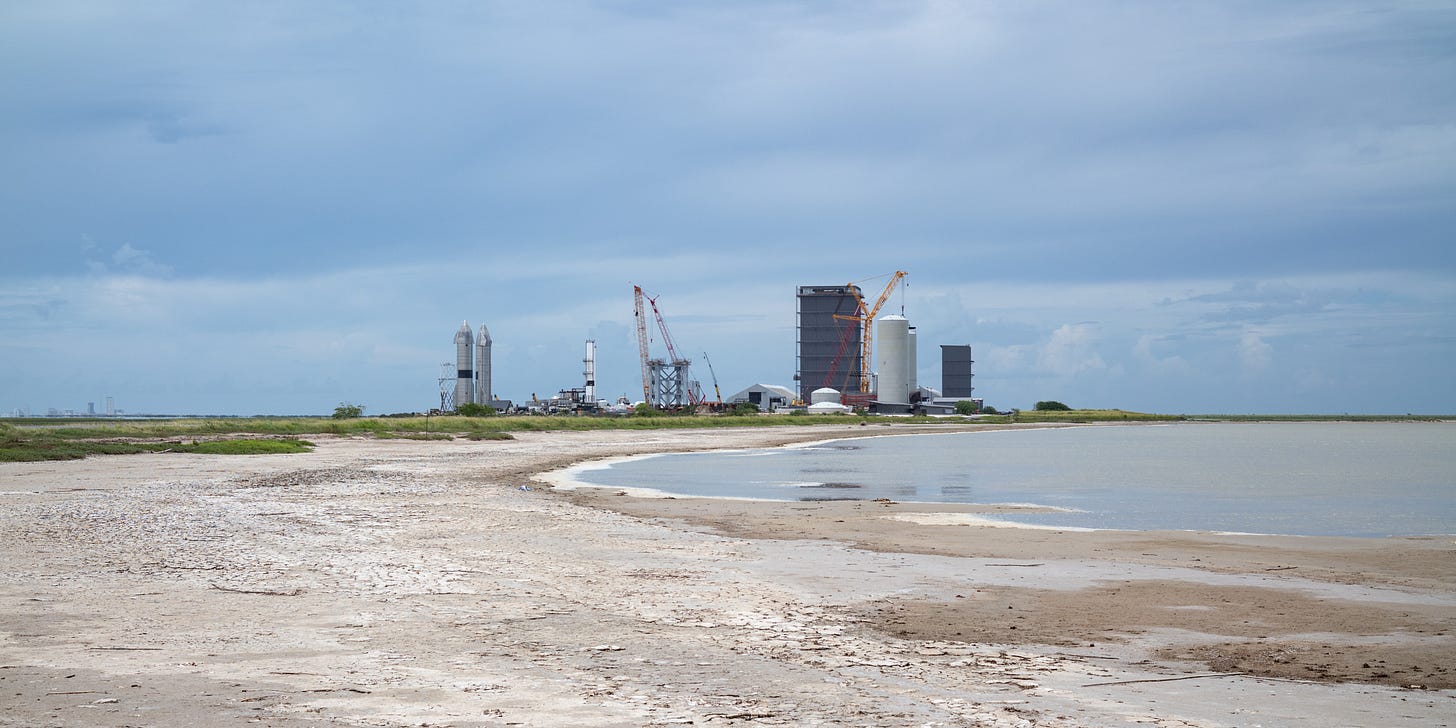Why SpaceX Turned a Launch Site into a Legal Enclave
Learning from other spaceport failures, SpaceX rewrote the rules to bypass regulation and public accountability

In early May 2025, a remote stretch of coastal Texas officially became the city of Starbase. The vote—212 in favor, 6 against—was cast almost entirely by SpaceX employees living near the company’s Boca Chica launch site. Elon Musk hailed the incorporation as a milestone in his campaign to colonize Mars. Mainstream media echoed the triumphalism, portraying Starbase as a bold experiment in streamlined governance—a high-tech company town reborn, promising jobs, innovation, and escape from bureaucratic inertia. But this framing obscures what Starbase actually reveals: not a break from the past, but the consolidation of a new mode of corporate territorial power.
Starbase reflects a broader techno-futurist worldview championed by Musk and others, in which existential threats are solved not through public deliberation but through private enterprise, accelerated infrastructure, and speculative engineering. Within this logic, the terrain of governance is something to be optimized—designed around operational efficiency, not democratic accountability. The creation of Starbase isn’t just about facilitating rocket launches; it was about building a legal and political architecture in which industrial imperatives override collective constraint.
To understand how this works, it helps to examine what didn’t work. In Camden County, Georgia, a comparable spaceport initiative collapsed under the weight of lawsuits, environmental regulation, and a successful citizen referendum. The failure in Camden was not due to technological limitations, but to the persistence of democratic friction. Starbase, by contrast, succeeded because that friction was preemptively engineered out.
Starbase exemplifies a shift in techno-statecraft—a strategic mode of infrastructural governance in which land control, legislative design, and demographic engineering are used to secure quasi-sovereign operating zones for private industry. What’s at stake is not just how rockets are launched, but how territory is governed. Understanding Starbase as a manufactured legal enclave helps clarify a broader transformation in which the frameworks of public accountability are not resisted—they are rewritten.
The Failure of Spaceport Camden
Camden County, Georgia, spent over a decade pursuing the dream of a commercial spaceport drawing on its legacy as a rocket testing site for the 1960s Apollo program. Beginning in 2012, local officials—most prominently County Administrator Steve Howard—framed the project as an economic catalyst, promising high-paying jobs, technological prestige, and a stake in the booming global space industry. A 2017 study by Georgia Southern University projected that Spaceport Camden could generate over $22 million in annual revenue for the area. The proposed launch site was a contaminated 11,000-acre former industrial complex along the Satilla River, previously home to Thiokol’s rocket motor testing and chemical production. The site had a long history of hazardous waste stemming from chemical manufacturing. Despite its toxic legacy, officials branded the plan “Spaceport Camden,” claiming it could attract firms like Vector and ABL Space Systems. Vector successfully conducted a test launch from the site in August 2017, and ABL Space Systems signed a lease with Camden County in 2018 for future operations.
By 2017, Camden had secured an option to purchase 4,000 acres and was pursuing FAA approval. Support came from select state legislators and Georgia’s economic development boosters, though enthusiasm at the state level remained cautious. Yet, a key challenge emerged early on. The site was flanked by sensitive coastal marshlands, residential communities on Cumberland and Little Cumberland Islands, and sat just miles from Kings Bay Naval Submarine Base. Launch trajectories would send rockets over inhabited land and federally protected areas. These risks were flagged by environmental groups, including One Hundred Miles and the Southern Environmental Law Center, which challenged the FAA’s Draft Environmental Impact Statement for violating NEPA and failing to consider realistic alternatives.
This was followed by a broader pattern of escalating public skepticism. Residents feared being displaced or put at risk during launches. Coastal landowners worried about access restrictions and fire hazards. More environmental advocates pointed to potential damage to right whale habitats and unresolved toxic waste concerns on-site. Meanwhile, no launch company had committed to using the facility. Even Vector, once touted as a partner, had gone bankrupt by 2019.
Despite the concerns, the FAA granted Camden a launch site operator license in December 2021—authorizing up to twelve small rocket launches annually. But the license alone did not guarantee liftoff. The county still needed to finalize its land purchase from Union Carbide, and that step triggered additional public backlash. A citizen-led petition forced a county-wide referendum on the acquisition. In March 2022, Camden voters rejected the purchase by a decisive margin. The county sued to nullify the result, but in February 2023, the Georgia Supreme Court upheld the referendum, effectively killing the project.
This failure revealed how democratic mechanisms—legal suits, public hearings, and direct votes—can block speculative infrastructure when perceived public costs outweigh promised benefits. Camden’s vision was undermined not by its technological infeasibility, but by its political and ecological unsustainability. The case shows what can happen when territorial projects remain embedded in procedural openness—accountability acts as a constraint, not a formality. It is precisely this constraint that Starbase was designed to bypass.
The Growing Success of Starbase
The groundwork for Starbase was laid in 2012, when SpaceX began purchasing property in Boca Chica, a low-income coastal village in Cameron County, Texas. Over time, the company expanded its land holdings, encouraged residents to relocate, and secured control over the area surrounding its South Texas launch site. But this wasn’t just infrastructure expansion—it was institutional engineering. SpaceX gradually built the legal, political, and demographic conditions necessary to insulate its operations.
By 2021, Elon Musk publicly floated the idea of creating a municipality called Starbase. That vision materialized in May 2025, when a vote among 218 local residents—nearly all of whom were SpaceX employees or affiliated—passed incorporation by a landslide: 212 in favor, 6 against. Three SpaceX employees ran unopposed and were elected as the city’s first officials. The move transformed a company-dominated worksite into a legal municipality, granting SpaceX control over zoning, infrastructure, and key regulatory decisions within the municipal limits.
One of the most contentious changes involved control over Boca Chica Beach. For years, SpaceX had to obtain county approval for closures during launches. That process became a logistical bottleneck. In response, the Texas Senate passed SB 2188, which would grant municipalities meeting specific criteria—criteria that really only applied to Starbase—the authority to unilaterally manage beach access. With incorporation and pending the passage of SB 2188 in the House, SpaceX poised to gained the legal means to schedule closures at will, sidestepping nearby local governments.
This consolidation of power has arrived despite mounting concerns. Environmental groups documented repeated violations, including unpermitted discharges and rocket debris littering protected areas. It’s failed rockets have repeatedly rained debris across the region, resulting in delayed flights and damaging property. The Carrizo/Comecrudo Tribe and other local activists protested the closure of ancestral lands and disruption of sacred sites. Residents of nearby Brownsville criticized the increasing privatization of public spaces, including the beach, which had once been freely accessible.
Yet SpaceX’s control over the area deepened. With over 260 employees living in the newly incorporated city and more than 3,000 commuting workers, Starbase is effectively a company town. The built environment also reflects this transformation—standardized housing, security checkpoints, and new facilities geared entirely toward supporting the Starship launch program. Federal agencies like the FAA and EPA have expressed concern but offered limited resistance, in part because jurisdictional lines had been effectively redrawn in SpaceX’s favor.
The Implications
The contrast between Camden and Starbase reveals two distinct trajectories for high-tech infrastructure—one shaped by public process, the other by preemptive legal design. Camden was filtered through open mechanisms like hearings, lawsuits, environmental review, and a binding referendum that made opposition legible and actionable. Its collapse stemmed from friction between speculative development and democratic oversight. Yes, democracy is a barrier to some. Starbase, by contrast, succeeded because that friction was eliminated from the start. Land control, tailored legislation, and employee-based voter rolls created a governance zone calibrated to corporate operations. The democratic procedures were not formally absent—but they were carefully orchestrated. Incorporation occurred through a managed electorate. Regulation was not avoided—it was rewritten to fit operational goals.
This model points to an emerging pattern of infrastructural sovereignty. In the name of innovation and efficiency, firms like SpaceX are increasingly operating within jurisdictions and special zones where regulatory delay, environmental contestation, and public accountability are structurally minimized. Starbase offers an example in a dynamic and evolving playbook—consolidate land, shape the rules, engineer the electorate, and transform logistics into law. As industries from energy to AI seek similar conditions, this approach risks institutionalizing a new corporate territoriality—one that erodes democratic oversight while formalizing mechanisms of private authority—all with the heavy hand of state intervention.
In sum, Starbase is more than a launch site—it is a prototype for a more private model of territorial governance. Its incorporation reflects how techno-industrial actors are learning not only how to navigate legal systems, but how to (re)build them in their image. Unlike Camden, which was shaped and ultimately blocked by mechanisms of democratic accountability, Starbase was crafted to neutralize those mechanisms from the outset.
What’s at stake here is not simply local control over spaceport development, but the broader trajectory of infrastructural power in the twenty-first century. As firms consolidate both economic and political authority under the banner of innovation, they are increasingly able to rewrite the terms of governance itself via the state legislature and with executive powers. In this new landscape, law and territory become tools of logistical efficiency, i.e. “innovation,” “competitiveness,” and other buzzwords, rather than arenas of public deliberation.
If Starbase is the new model of privatization, communities across sectors may find themselves confronting similar projects designed to bypass their voice in the matter. Importantly, democratic structures, once sidelined, do not automatically return. Reclaiming them will require not just vigilance, but a reinvention of how we govern infrastructure in the public interest.







It’s easy (and not incorrect) to say SpaceX went a bit too far on this one - but if you’ve ever had to deal with NEPA, you can be sure that that process *also* goes too far, albeit in the opposite direction. While in Camden it was used for a direct-democratic result, in other locales (eg, all over California) it is simply used for bureaucratic stonewalling, indefinite progress-stymieing and rent-seeking.
It seems both the extreme of 100% bureaucracy and 100% corprocracy don’t provide ideal outcomes. In this case, the person or people who determine the balance… is/are the sovereign.